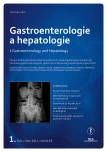Successful use of OTSC® (Over-The-Scope Clip) in the treatment of iatrogenic colon perforation
Authors:
M. Stefanová 1; J. Martínek 1; F. Závada 1; Š. Suchánek 1; D. Langer 2; I. Buřič 3; M. Ryska 2; M. Zavoral 1
Authors‘ workplace:
Univerzita Karlova, Interní klinika 1. LF UK a ÚVN Praha
1; Univerzita Karlova, Chirurgická klinika 2. LF UK a ÚVN Praha
2; Radiodiagnostické oddělení, ÚVN Praha
3
Published in:
Gastroent Hepatol 2011; 65(1): 30-32
Category:
Digestive Endoscopy: Case Report
Overview
Bowel perforation during diagnostic colonoscopy occurs at a frequency of 0.09%. The risk of perforation is higher in elderly women after surgery or in those with diverticular disease. Our case report describes the first successful use of OTSC® (Over-The-Scope-Clip) in the Czech Republic in the treatment of iatrogenic perforation of the sigmoid colon occurring during diagnostic colonoscopy.
Key words:
perforation – OTSC®
Sources
1. Voermans RP, van Berge Henegouwen MI, Bemelman WA et al. Novel over-the-scope-clip system for gastrotomy closure in natural orifice ransluminal ndoscopic surgery (NOTES): an ex vivo comparison study. Endoscopy 2009; 41(12): 1052–1055.
2. Damore LJ, Rantis PC, Vernava AM et al. Colonoscopic perforations. Etiology, diagnosis, and management. Dis Colon Rectum 1996; 39(11): 1308–1314.
3. Martínek J, Kovačová S, Nosek V et al. Successful endoscopic treatment (clipping) of esophageal perforation dutiny balloon dilatation in a patient with achalasia. Endoscopy 2008; 40: E61–E62.
4. Seebach L, Bauerfeind P, Gubler C. Sparing the surgeon: Clinical experience with over-the-scope-clips for gastrointestinal perforation. Endoscopy 2010; 42 : 1108–1111.
Labels
Paediatric gastroenterology Gastroenterology and hepatology SurgeryArticle was published in
Gastroenterology and Hepatology

2011 Issue 1
Most read in this issue
- Cytomegaloviral colitis in organ transplant recipients
- Is it possible to reintroduce original biological therapy in a relapsed Crohn’s disease patient?
- Acute mesenteric ischemia
- Autoimmune form of chronic pancreatitis and IgG4 positive mastitis
